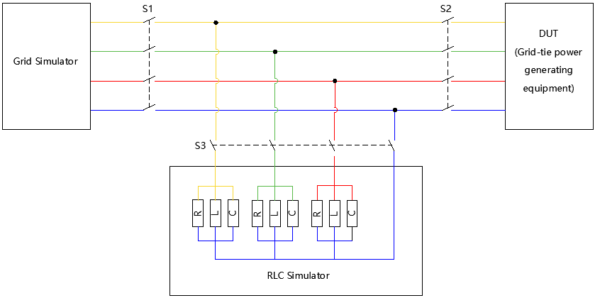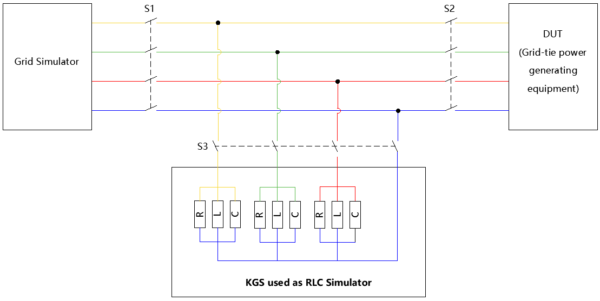Email:
contact@bridgetech.com.sg
Islanding may occur when the power supply of the Grid is interrupted due to electrical failure or natural factors. In order to prevent the adverse impact of islanding effect on grid system safety and power quality, IEC62116-2008, VDE0126-1-1, IEEE1547 and other standards put forward a series of provisions, requiring that the islanding effect can be detected and controlled in time for grid-tie power generation equipment. The traditional test of these equipment usually adopts passive programmable AC load simulator, which can set any combination of resistance/inductance/capacitance.

Figure 1
For the test standard and application of grid-tie power generation equipment, BriPower KGS series has launched the -RLC option for islanding test, which is used to simulate the R/L/C circuit components. Compared with the traditional passive load, it has the advantages of more economy, simpler operation, smaller dimension and weight, etc. In addition, the standard KGS can be used as a grid simulator to test distributed generation systems, such as the electrical characteristics of energy storage PCS, PV inverter, etc. The simulation functions are diverse and can meet the requirements of grid tied DG regulations testing.
The BriPower KGS series is a high-performance AC/DC power source, using SiC MOSFET PWM technology, which contains multi output power levels from 15kVA to 500kVA. With an output frequency range from DC to 2kHz (standard 1kHz, 2kHz with -HF option), standard output 300V L-N (-HV1 option: 0~375V, -HV1 option: 0~750V).
KGS used as Grid Simulator
KGS series can be used as a grid simulator to test distributed generation systems, such as the electrical characteristics of energy storage PCS, PV inverter, etc. The test system diagram is shown in Figure 2. The simulation functions include voltage and frequency fluctuation, voltage drop, high voltage ride through, low/zero voltage drop, three-phase unbalance, harmonic and inter-harmonic etc. KGS series can meet the requirements of grid tied DG regulations testing, such as: grid voltage abnormality test, grid frequency abnormality test, high voltage ride through test, low/zero voltage ride through test, anti-islanding test, etc. KGS series provides standard software that can simulate various real-world power grid operating conditions and supports multiple parameter settings.

Figure 2 KGS used as Grid Simulator
When KGS is used as programmable RLC load simulator (-RLC option), it can be used for islanding test of grid-tie power generation equipment. The test system diagram is shown in Figure 3. KGS-RLC can adjust the parameter values of R, L and C components in the provided software interface according to the user’s test requirements, which effectively simplifies the cumbersome steps of multiple connection and modification. The features are as follows:

Figure 3 KGS used as RLC Simulator
KGS-RLC can not only be used for islanding test of grid connected power generation equipment, but also simulate complex impedance combinations of R, L and C components. The three phases are independent and controllable, and the electrical parameter values can be set respectively. The specific topology is shown in Figure 4.

Figure 4 KGS used to Simulate Complex Impedance Combinations
